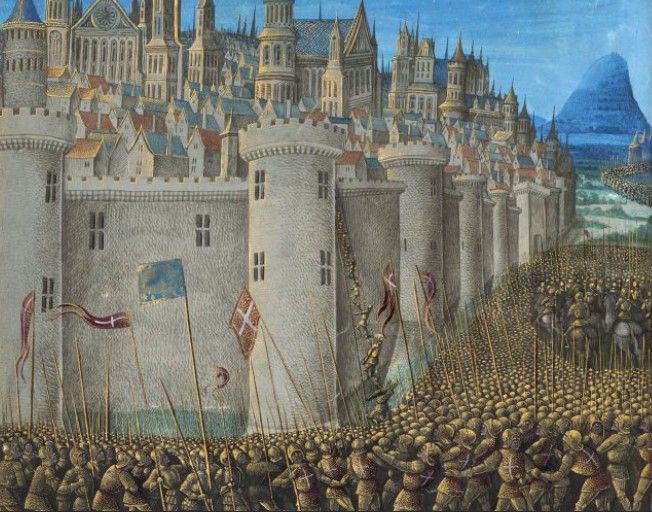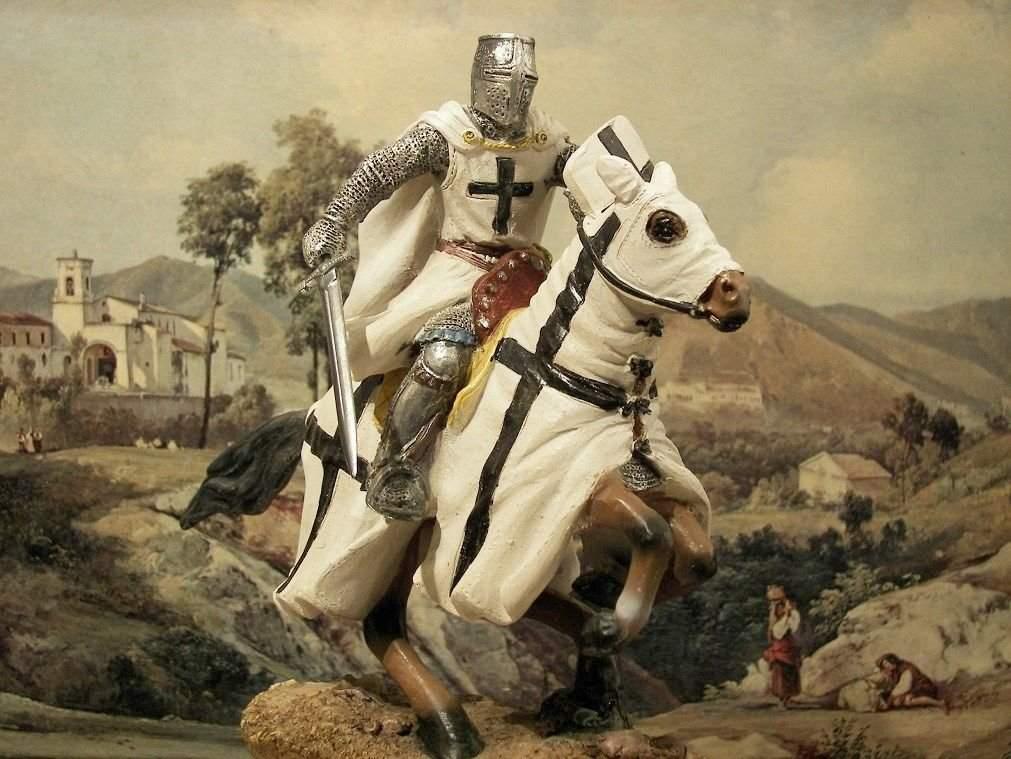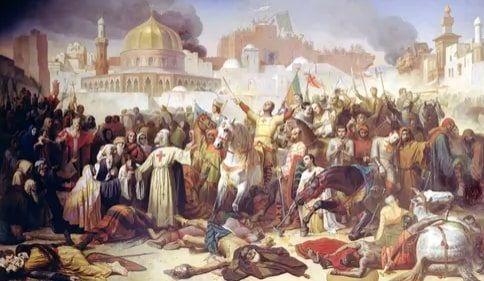INTUSK MAGAZINE
TO THE CORE OF YOUR HEART
The Third Crusade (1189-1192)
April 16, 2023
The third Crusade, also known as the "Kings' Crusade" due to the three European monarchs involved, took place between 1189 and 1192 A.D. in order to retake Jerusalem after it had been captured by the Muslim leader Saladin in 1187. Frederick I Barbarossa (King of Germany and Holy Roman Emperor), Philip II of France, and Richard I the Lionhearted were the three monarchs.
The crusade failed, and the Holy City was not retaken. There were some victories along the way, including the capture of Acre and the battle of Arsuf.
The Fall of Jerusalem
After the death of King Baldwin IV of Jerusalem in 1185, his nephew was crowned as Baldwin V under the regency of Count Raymond III of Tripoli. Following Baldwin V's death the following year, his mother, princess Sybilla, crowned herself queen and her husband, Guy of Lusignan, king. Raynald of Chatillon, who had backed Sybilla's claim to the throne, raided a wealthy caravan travelling from Egypt to Syria and imprisoned its passengers, breaking a truce between the Kingdom of Jerusalem and Saladin.
After seizing control of Damascus in 1174, Saladin, the founder of Egypt's Ayyubid dynasty, stunned the world by defeating the army of the Kingdom of Jerusalem and its Latin allies at the battle of Hattin in 1187 A.D. When Pope Urban III learned of the Battle of Hattin, he is said to have collapsed and died.
The new Pope, Gregory VIII, called for another crusade to reclaim Jerusalem and holy relics such as the True Cross.
Crusade of Frederick I Barbarossa
In Strasbourg, Frederick imposed a small tax on German Jews to fund the crusade. He also protected the Jews and forbade anyone from preaching against them.

Frederick felt it was necessary to notify Saladin of the termination of their alliance because they had signed a treaty of friendship in 1175. He dispatched Count Henry II of Dietz to deliver an ultimatum to Saladin on May 26, 1188. The sultan was ordered to withdraw from the lands he had conquered, to return the True Cross to the Church of the Holy Sepulchre, and to make amends for Christians killed in his conquests; otherwise, Frederick would renege on their treaty.
The first of the three kings to set out for the Holy Land was Frederick I Barbarossa. On May 11, 1189, Frederick set out with an army of 12,000–20,000 men, including 2,000–4,000 knights. Estimates for Frederick's army ranged from 10,000 to 600,000 men, including 4,000–20,000 knights, according to contemporary chroniclers. After leaving Germany, Frederick's army was supplemented by a contingent of 2,000 men led by Hungarian prince Geza, the younger brother of Hungary's King Bela III, and Bishop Ugrin Csak.
The Byzantine Emperor Isaac II Angelos (1185–1195) was understandably wary of this western army passing through his territory, while westerners were deeply suspicious of Isaac's new alliance with Saladin, a feeling that had some basis in reality, as Isaac did try to obstruct the Crusaders' progress towards the Middle East. When Frederick took over Adrianople in Thrace, the Byzantines became more helpful to their Christian neighbours.
Frederick was promised safe passage through Anatolia by the Turkish Sultanate of Rum, but instead faced constant Turkish hit-and-run attacks on his army. A Turkish army of 10,000 men was defeated by 2,000 Crusaders at the Battle of Philomelion, with 4,174–5,000 Turks killed.
While crossing the Saleph River on June 10, 1190, Frederick's horse slipped, throwing him against the rocks; he then drowned in the river. After this, much of his army returned to Germany by sea. The Emperor's son, Frederick of Swabia, led the remaining 5,000 men to Antioch.
Crusade of Richard and Philip
Richard and Philip II met in France at Vezelay and travelled together as far as Lyon on July 4, 1190, where they parted after agreeing to meet in Sicily. When Richard arrived in Marseille, he discovered that his fleet had not arrived; he quickly became impatient and, after hiring ships, set sail for Sicily on August 7. When the English fleet arrived in Marseille on August 22, they discovered Richard had left and sailed directly to Messina, arriving before him on September 14. Philip had hired a Genoese fleet to transport his army to the Holy Land via Sicily, which included 650 knights, 1,300 horses, and 1,300 squires.

William II of Sicily had died the previous year, and was replaced by Tancred, who imprisoned Joan of England, William's wife, and King Richard's sister. Richard captured the city of Messina on October 4, 1190, and Joan was released. Philip left Sicily directly for the Middle East on March 30, 1191, and arrived in Tyre in April; he joined the siege of Acre on April 20.
Richard I then conquered Cyprus in May 1191 CE. The island's inhabitants were forced to pay a 50% tax on all possessions to further boost the Crusader king's campaign coffers. The Crusaders would govern the island, which was subsequently used as a supply base for armies on their way to the Middle East, until the Venetians took over in 1571 CE.
The Siege of Acre

King Guy turned his attention to the port of Acre after failing to take command of the Christian forces at Tyre. He assembled an army to besiege the city, with the help of Philip's newly arrived French army. The combined armies were not enough to counter Saladin.
Richard arrived in Acre on June 8, 1191, and immediately began supervising the construction of siege weapons for an assault on the city, which was captured five weeks later on July 12. Richard then ordered the execution of 2,500 prisoners. The English king felt that the delay in paying the agreed-upon ransom for them required a firm retort, and that releasing them would only mean they would eventually rejoin the enemy army. Saladin retaliated by slaughtering all of the Christian captives he had captured.
In the struggle for Jerusalem's throne, Richard backed Guy, while Philip and Leopold backed Conrad, who was related to them both. Guy was to rule indefinitely, but Conrad was to inherit the throne upon his death.
The Battle of Arsuf
Following the capture of Acre, Richard decided to march to Jaffa. Before an attack on Jerusalem could be launched, Jaffa had to be taken control of. On September 7, 1191 CE, the two armies clashed in a running battle on the plain of Arsuf, with the Crusaders being careful to follow the coast and thus leave only one flank of their column exposed. After a day of skirmishing, the westerners' heavy cavalry was unleashed to devastating effect. The battle was won by the Crusaders. Saladin had no choice but to flee to the relative safety of the plain's bordering forest.
After that, the Crusaders marched to Jaffa to rest and regroup. Despite Richard's preference for first securing Egypt and isolating the enemy's logistical base, the majority of the Crusaders were dead set on attacking Jerusalem. As a result, by January 1192, the Crusader army had yet to reach its goal.
Advance on Jerusalem
The Crusader army advanced inland toward Jerusalem in November 1191. Saladin was forced to disband the majority of his army on December 12, due to pressure from his emirs. After learning this, Richard pushed his army forward, spending Christmas at Latrun. Appallingly bad weather, including heavy rain and hailstorms, combined with the fear that if the Crusader army besieged Jerusalem, it would be trapped by a relieving force, led to the decision to retreat back to the coast.
However, following an election by the kingdom's nobles in April, Richard was forced to accept Conrad as king of Jerusalem. Guy had received no votes at all, so Richard sold him Cyprus as compensation. Conrad was stabbed to death in Tyre's streets by two assassins before he could be crowned. Eight days later, Richard's nephew, Henry II of Champagne, married Queen Isabella, who was pregnant with Conrad's child.
Meanwhile, the Muslim leader decided to attack Jaffa, which was taken in July 1192 CE. Richard, who was then in Acre, sailed to Jaffa on August 1, determined to reclaim the city. Richard's forces stormed Jaffa from their ships. The Ayyubids, who had been unprepared for a naval attack, were driven from the city.
Following his defeat at Jaffa, Saladin was forced to sign a treaty with Richard on September 2, 1192, ensuring that Jerusalem would remain under Muslim control while allowing unarmed Christian pilgrims and traders to visit the city. It was eventually agreed that Ascalon would be returned to Saladin's control, with its defences demolished.



